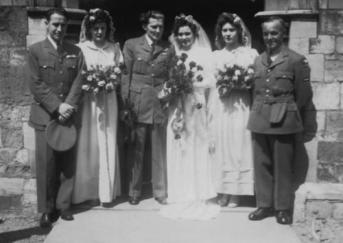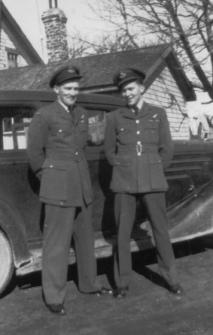Wartime Heritage
ASSOCIATION

Looking back some seventy five years it is truly amazing how a chance encounter between two people in Mildenhall, Suffolk,
England, during World War II would eventually effect in such a positive way the small town of Yarmouth, Nova Scotia, so far away
across an ocean in Canada. The lives of the young men and women of the wartime generation need to be recalled and celebrated
for much can be learned from remembering their courage and determination in difficult times, but perhaps it is even more
important for our modern generation to understand how they helped built and shape their community in those years that followed
World War II. Such is the story of Elsie and Knowles Crosby.
Elsie Vera Blakeman was fourteen years old when World War II began. She lived in
the suburbs of Grimsby, along the east coast of England, some 200 miles north of London
where she attended a girls school from the ages of eleven to sixteen. Grimbsy. was not a
target for bombing, but there were sleepless nights from artillery and German planes
flying to bomb the industrial areas of Yorkshire.
On finishing school Elsie worked with an elderly lady in her convenience store
waiting for the age of eighteen when it would be mandatory for her to contribute to the
war efforts. In England, during the war, as soon as a person turned eighteen they had to
do something “useful” for the country. This could include working in a factory, or on a
farm, or joining the services.
Contributing to the war effort was not new to the Blakeman family. Elsie’s mother
had left her job as a teacher and joined the Royal Navy during World War I. Easily
seasick and not wanting to join the Land Army or the Army Elsie enlisted in the Royal Air
Force.
Following basic training she was posted to Mildenhall, a large RAF Station in
Suffolk. The base accommodated three Squadrons, 419 RAF Squadron, to which she
was attached, 75 New Zealand Squadron, and the 419 Canadian Squadron 419 in it’s
formative stages.
The W.A.A.F.’s lived in married quarters, and Elsie shared a large room with Doreen, a girl from the outskirts of London.
Her assignment was in the ration offices at Mildenhall where she was would order the rations and distribute them to each of the
three fligth squadrons. Elsie also distributed three different menus of food to the three different mess halls. The mess halls were
for the three sections of ranks on the station.
During her time at Mildenhall, Elsie had the opportunity to meet and shake hands with the King and Queen and with the
British Prime Minister, Winston Churchill, during their visit to RAF Station Mildenhall.
German fighters bombed the station on a few occasions; however, Elsie was not injured. Grimsby, Elsie’s home town, being
near the coastline, was an easy target for enemy fighters, although they rarely attacked. However, on one day, while Elsie was on
leave at home, she was riding her bicycle down a street when a German fighter flew in from over the ocean coming toward her
ripping up the street with machine gun fire. She hardly knew what was happening because it all seemed to happen so quickly. “It
was quite scary, after I realized what was happening. Fortunately, a man got to me quickly and pulled me off my bike and
pulled me to safety behind a car”
On another occasion when Elsie was on leave, she took the train to Birmingham with the intent of returning to Mildenhall by
train. When she returned to the Birmingham Station it no longer existed. It had been bombed and the train could not get through.
She was forced to take a bus back to Mildenhall.
Elsie led a chaotic lifestyle at the RAF station. “There were always pilots and crew landing and eating and then taking off
again at all times of the day. Some did night raids and some did day raids, so it was always busy. It was like living in another
world. People were so nice to each other and they shared whatever they had. People lived like there wasn’t going to be a
tomorrow. It was sad too, we would be talking to a couple of young men before they were off, and then the next day we would
hear that they never made it back, that they had been shot down.”
There were no flower gardens in England during the war because of the strict rationing. “Instead of planting flower gardens,
you would plant vegetable gardens instead. People ate rabbits and other substitutes for meat, since red meat was so hard to
get. You never had to worry about getting fat. It was good for me though, because my grandfather had an orchard.”
There were not many people who could afford to have a car in England during the war because almost all petrol was sent to
the war effort. “There were good bus services though. A big double-decker would come every twenty minutes, so you could easily
get where you needed to be.”
There were lots of young men at Mildenhall and as she met more and more of them she found it very difficult to hear night
after night that two or three crews had not returned. Like many people, she prayed for clear moonlight nights when flights had to
be cancelled.
The first plane of Canadian Squadron 419 to fly on operations over Germany was piloted by
Wing Commander Jon 'Moose' Fullton. His wireless operator and gunner was Knowles 'Bing”
Crosby. After two operational flights Knowles then flew with Flight Sergeant M. L. Swanson.
Knowles Crosby had attended Port Maitland school leaving to work in the lumbering
industry. In 1940 he was employed in a warehouse in the Annapolis Valley, NS, when he applied
for enlistment in the RCAF. In September, 1940 he was sent to Brandon, Manitoba, Maning
Depot. He was then sent to Initial Training School at Regina, the wireless school at Calgary,
finishing his training at Fingal, Ontario, bombing and gunnery school.
He arrived in England
in January 1942 and was stationed at RAF Mildenhall.
Knowles took part in raids on Cologne, Paris, Rostock and eight trips to the Rhur Valley.
Their aircraft was the two-motor ‘Wellington’ nicknamed the ‘Wimpy’. The plane had a six man
crew. Throughout the late winter and spring some of the attacks were on targets in Occupied
France and against Hamburg, Bremen, Wilhelmshaven. By June Knowles was reaching the end of
his tour.
The bombers returned to the Ruhr Valley and the aircraft encountered opposition both
over the target and on the journey home. Knowles’ aircraft ran into trouble over Essen when a
chunk of explosive shell casing (flak) struck the rear end of the fuselage, and forced Swanson, the pilot, to jettison his bombs
short of the target. Limping home with almost mortal wounds, the plane was hit again over Antwerp and the underside of the
fuselage caught fire from the front turret to the navigator’s table. A twin-engine Luftwaffe night fighter chose that moment to
finish off the blazing aircraft and during the engagement, both the second pilot and the front gunner were wounded; the bomb bay
doors dropped open; the wheels dropped down and the aircraft, after stalling, fell from 15,000 to 200 feet before Swanson could
regain control. Flight Sergeants P. S. O. Brichta , the navigator, and Knowles Crosby, as wireless operator, succeeded in stamping
out the fire after which Knowles made the wounded second pilot comfortable. He then returned to his shot up radio to send out an
SOS. The radio could not receive; however, ground crews received the message and tired in vain to help them find a landing place.
Swanson finally crash-landed the plane in a field and with the exception of the second pilot, the crew stepped out unhurt.
All three flight sergeants were awarded the Distinguished Flying Medal from King George Vl.
Knowles was given ten days leave and on learning of his award modestly remarked, “I don’t know why
they gave it to me.” When he was pressed for for information as to his trips he would comment, “I
didn’t find the last Ruhr raid so exciting for we were too darn busy during the whole time.”
Knowles had asked Elsie out for a date a few times but initially she refused. Elsie had two
unpleasant experiences with Americans and thought Canadians were the type of characters. But, during
a chance meeting at a café while with friends, she realized he really was very nice.
Elsie and Knowles dated regularly as good friends until that morning following Knowles’ thirtieth
operation flight. Knowles’ plane was reported missing. But, later that day three of the crew, including
Knowles, arrived back at Mildenhall.
This near death situation brought the
realization that they had stronger feelings than
friendship for each other. They became engaged.
Elsie took him home to meet her family and four
months later on July 24, 1943, they were married in the old Norman Church
where she had attended as a child.
At this time Knowles had finished one tour of operations and had
started a second tour with the Wing Commander of 432 Squadron, flying in
Lancasters out of Skipton in Yorkshire. While they were on their honeymoon
a friend took Knowles’ place on an operation over industrial Germany. The
plane was shot down and only one of the crew survived.
Knowles became the station Signal Officer in charge of the wireless
operators and Elsie obtained a posting to a nearby RAF Station. Three months later Knowles was posted to Ottawa as a member of
the 'Special Cases Board'. The only way Elsie could leave the Air Force to join Knowles was if she was pregnant. She happily
discovered that was the case and received a discharge from the RAF. She went home to wait to hear when she could join Knowles.
She spent Christmas with her family, and in February, 1944, she received her ticket on the Empress of Scotland leaving Liverpool
for Canada on March 17. Knowles had departed from Canada a month and a half earlier.
“I was excited but when I hugged my mother her eyes were filled with tears. She said, ‘It is so far away’. I now know the
pain and anxiety she was feeling. I was nineteen years old, her eldest child, three months pregnant and leaving for a place so far
away I might not see her again. I had always had a role in the nurturing of the four younger children, so when it came time to
leave, I cannot describe the overwhelming emotion and anxiety I felt. On the way to Liverpool, the realization of the drastic
change shortly to take place in my life came to me with a shock. What was I doing?”
Elsie boarded the ship in time for dinner. and as the wife of an officer she had a seat at the captains table. “The selection of
food was amazing, much of it I had not seen for years. The roast beef was delicious but I really enjoyed the white bread and real
butter. That dinner was the only solid food I had for twelve days”.
The ship left in a convoy and set out on a northerly route. German U-boats were very active in the Atlantic Ocean at that
time. Returning troops were on the lower decks of the ship so the ship was a target. The sea was very rough and Elsie was seasick.
Everyone had to go on deck every day, put on life jackets and go through lifeboat drills. On one occasion they were summoned to
the deck late in the day and had to stay there in the cold and wind until some kind of threat had passed. The doctor came to see
Elsie every day and gave her nutritious liquids. Finally on the evening on the twelfth day the ship arrived in Halifax.
Elsie was the only passenger destined for Nova Scotia. At approximately 7 a.m. A Red Cross worker came on board and
escorted her to Pier 21. There she went through the immigration procedure, after which she was taken to the train waiting just
outside the building. It left at 8 o’clock and she was on the last part of her journey.
She had been on the train for eight and a half hours when the conductor came along and told her to prepare to get off at the
next station. She gathered her belongings and went to the door. When it opened she was in shock. There was nothing in sight but
a short board walk, bushes, trees and a narrow path. “I said: "This can’t be Yarmouth". He said it was not, my ticket had South
Ohio as my destination. The Crosby family lived in the rural area not far from the village of South Ohio as my destination. The
Crosby family lived in the rural area not far from the village of South Ohio, consequently his postal address was R.R.1, South
Ohio. I had to exit the train”.
There was a small elderly man heading up the path and she decided to follow him. She was beginning to feel a little panic.
She was still walking through bushes without a sign of anyone else or a building. She stopped for a rest and when she did the man
came back. He said he knew the Crosby family and that something had gone wrong somewhere. He thought the best idea was to
take her to the village store where she could make a phone call.
Meanwhile, Knowles was waiting for her at the North end Yarmouth station, and when the train arrived there without her he
was very concerned and went to the station in the south end of Yarmouth which sometimes carried passengers. The family had
difficulty locating him.
The couple who owned the store, Elroy and Helen Moses, took Elsie to their home for supper. “There I had my first taste of
home bake beans and brown bread. It was delicious.”
Knowles’ brother and wife picked Elsie up. “I was so happy to arrive at the Crosby farm and be with my husband again. His
parents were kind, rather shy people who made me very welcome.”
“Three days after I arrived I had a telephone call from Halifax police telling me the disturbing news that my trunk, which
had been stored in the hold of the ship, had been stolen. When he told me the chances of finding it were slim, I was devastated.
It contained all my wedding gifts including a chest of silverware from the WAAFs. on the station. Also included were new clothes
for which my family and friends had sacrificed their clothing coupons. Several weeks later two stevedores were arrested for
stealing luggage from incoming ships. Nothing of mine was ever recovered.”
“A few days later, Knowles’ mother told us the people of Port Maitland,
where Knowles went to school, were having a 'shower' to honour Knowles and
meet me. Until that time a shower to me was a brief period of rain. I had no
idea what to expect. When we entered the hall I was shocked - it was literally
full of people. There were even some English service men there, members of
the British Fleet Air Arm stationed at Yarmouth’s East and West Camps. We
were taken to a particular place and people filed by to shake hands and
congratulate Knowles. Their local boy had become a Flight Lieutenant, won a
medal for valour and brought home a foreign wife. The first war bride in the
area. I think there were some disappointed local girls. My face ached from
smiling and my hand was numb by the time we had greeted everyone.”
“Following this, we were presented with one hundred dollars to help to
buy new silverware, a blanket and a bouquet of roses. I really appreciated
their kindness and thoughtfulness and told them so.”
Ten days later, Elsie and Knowles departed for Ottawa. Their son was
born on July 9, 1944.
Fourteen months later Knowles was transferred to Lachine, Montreal.
After V.J. Day, Knowles’ thoughts turned to leaving the Air Force. He was
offered a permanent position as the wireless operator mapping the northern
regions. He declined the position. He wanted a more settled life, preferably in
Nova Scotia.
They moved to Dartmouth, and Knowles took training to be a Government Fishery Inspector. While he liked the work, he was
moved three times in just a few months. He resigned as they both thought it was time they bought a home and settled down.
They found a bungalow on the outskirts of Yarmouth on two acres of land. “Now Knowles had to decide what his future was
going to be. He was brought up on a farm, but that was not an option. Before I agreed to become engaged I exacted a promise
form Knowles that he would never be a farmer. That life never held any appeal for me”. Knowles bought a 38 foot fishing boat
and equipment, hired a man and went lobster fishing. He did well but this was not to be a permanent undertaking.
In 1950 their daughter, Debra, was born.
Knowles had been doing a lot of landscape gardening and business was increasing. When some rather derelict greenhouses of
75,000 square feet, became available they decided it might be a good investment. “We worked incredibly hard to build up the
business. After nearly two years, when the future was beginning to look bright, a fire burned out the shop and parts of two
greenhouses. Wiring that had not been replaced was the cause of the fire. We were devastated, but decided later that it brought
about a fortunate change. It was rebuilt as a retail business. I went to Hamilton to take a concentrated course at the Canadian
School of Floral Art. It extended our business, which was successful for thirty years. I loved the work and the contact with the
public.”
Knowles and Elsie built a house next door to the business and decided to try and be successful by being available at all hours,
being honest and giving value for money. “it worked.”
When they had a shop on Main Street, Yarmouth, their children were teenagers and they had two, then three, employees.
Elsie decided she would do some voluntary work. She had been in a choral group, the church choir, I.O.D.E. (Imperial Order
Daughters of the Empire), Home and School and Lionettes. Both she and Knowles had been curling and golfing since the early
sixties and had been in Provincial Competitions.
Elsie’s accomplishments became numerous as she became more and more involved in her community. Her family and
sharing their business were always the most important. Her involvements were:
President & Secretary of Yarmouth Ladies Curling Association
President & Match Chairman of Yarmouth Ladies Gold Club
Member of Yarmouth Recreation Committee
Zone Chairman for N.S. Ladies Curling Association
President for N.S. Ladies Curling Association
Chairman for N.S. Curling Association Provincial Championship
Member of the Board of Sport Nova Scotia
Delegate to the Canadian Ladies Curling Association, later elected to the board
President of Canadian Ladies Curling Association
Chairman of Curl Canada (Curling in Canada)
Representative at the Olympic Trials and the Ladies World Championship
Joined the Canadian Curling Hall of Fame Board
Chairman of the Selection Committee (Canadian Curling Hall of Fame)
Devised a system of evaluation (Canadian Curling Hall of Fame)
Induced into the Canadian Curling Hall of Fame
President and Secretary of the Ladies Golf Division (Yarmouth)
Regent (President) and Education Secretary - I.O.D.E. (Imperial Order Daughters of the Empire),
Home and School
Member Lionettes.
Member of Holy Trinity Anglican Church (fifty-six years)
Member of the Church choir (fifty years)
In
Nova
Scotia
Elsie
joined
the
Board
of
the
Nova
Scotia
Hall
of
Fame
for
three
years
then
came
back
to
Yarmouth
to
be
with
the Yarmouth Area Sport Heritage Association. She was involved with the S.P.C.A. for twenty five years
Among Knowles’ involvements were:
President of the Yarmouth Curling Club
Charter member of the Lions Club
Member of the Y's Men's Club,
Member of the South West Air Forces Association
Member of the Port Maitland Royal Canadian Legion.
Elsie and Knowles eventually retired as owners of Crosby's Florist after thirty-five years in business.
Knowles
died
on
January
17,
2004.
Elsie
died
on
December
27,
2011.
Both
left
a
legacy
of
their
participation
in
and
contribution to their community. They both serve as the finest of the wartime generation.
Elsie and Knowles Crosby
The Wartime Generation
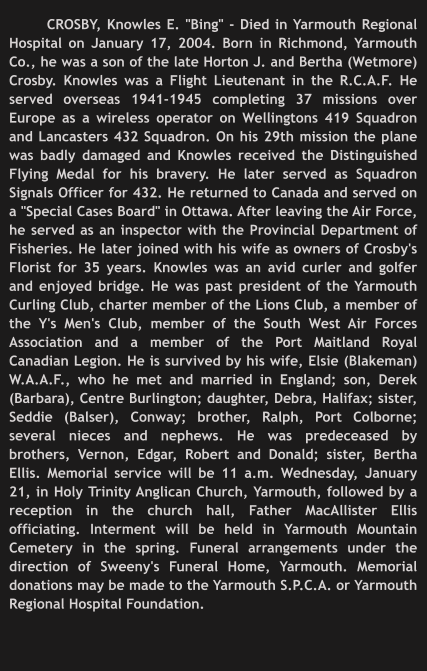
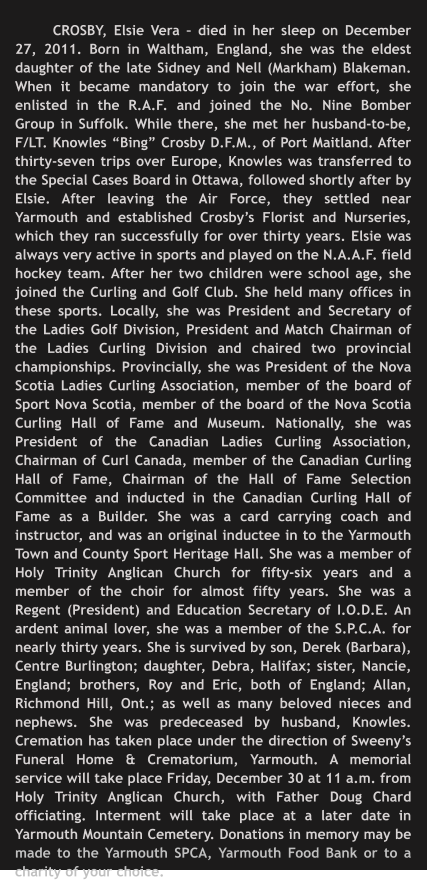
Sources:
Interview by Colin Dempsey, history student at Yarmouth Consolidated Memorial High School (May 6, 2005)
http://www.pier21.ca/stories/english-war-bride-elsie-crosby
http://www.cmp-cpm.forces.gc.ca/dhh-dhp/his/docs/RCAF_Overseas_vol1_e.pdf
http://sweenysfuneralhome.net/book-of-memories/1512407/Crosby-Elsie/index.php
http://www.nsobits.ca/nsobits/list-name.asp?ID=17617
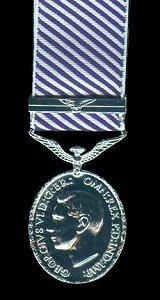
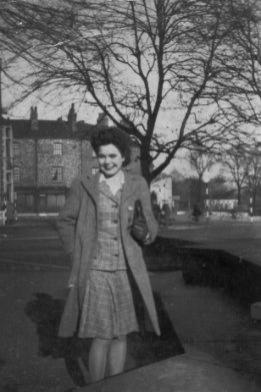
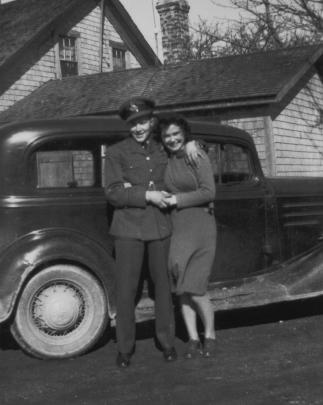


copyright © Wartime Heritage Association
Website hosting courtesy of Register.com - a web.com company
Elsie and Knowles Crosby
The Wartime Generation


- World War I - Menu
- WWI Stories and Articles
- Photos - Yarmouth Soldiers
- Selection of World War I Songs
- WWI Casualties of Yarmouth, NS
- Those Who Served - Yarmouth, NS
- WWI Casualties Digby Co. NS
- WWI Casualties Shelburne Co. NS
- Merchant Mariners (1915) Yarmouth, NS
- Canadian Forestry Corps - Non Yarmouth Birth/Residence Enlistments
- US Draft Registry - Yarmouth NS Born


- World War II - Menu
- WWII Stories and Articles
- Telegraphist Air Gunners
- WWII Casualties of Nova Scotia
- US Casualties with NS Connection
- Far East/Pacific Casualties with NS Connection
- Merchant Navy Casualties Nova Scotia
- Nova Scotia WWII Casualties Holten Canadian War Cemetery
- D-Day Casualties - Nova Scotia
- CANLOAN Program Casualties - Nova Scotia
- Battle of the Bulge Casualties - Nova Scotia
- WWII Casualties Yarmouth NS
- Yarmouth Casualties - RCAF RAF Canadian Army WWII
- Yarmouth Co., Marrages WWII
- Casualties Non-Born/Residents with Connection to Yarmouth Co., Nova Scotia.
- WWII Casualties Digby Co., NS
- Non-Nova Scotian WWII Casualties Buried in Nova Scotia
- WWII RCAF Casualties Aged 16-18
- Brothers/Sisters Who Served - World War II
